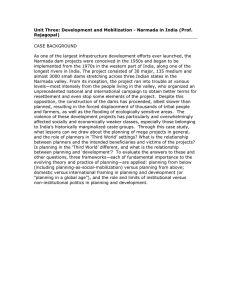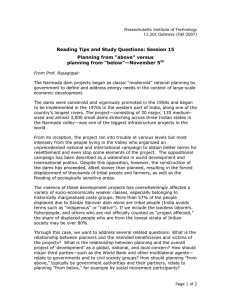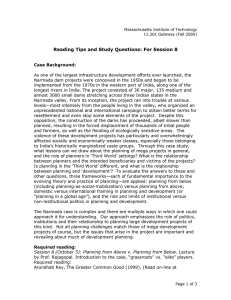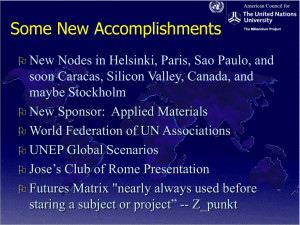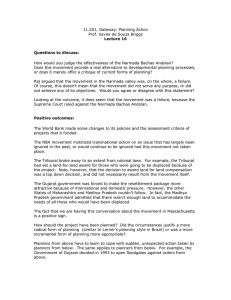Successes and Failures of the Narmada Bachao Andolan and Reasons... Them The long history of the Narmada Bachao Andolan’s struggle with...
advertisement
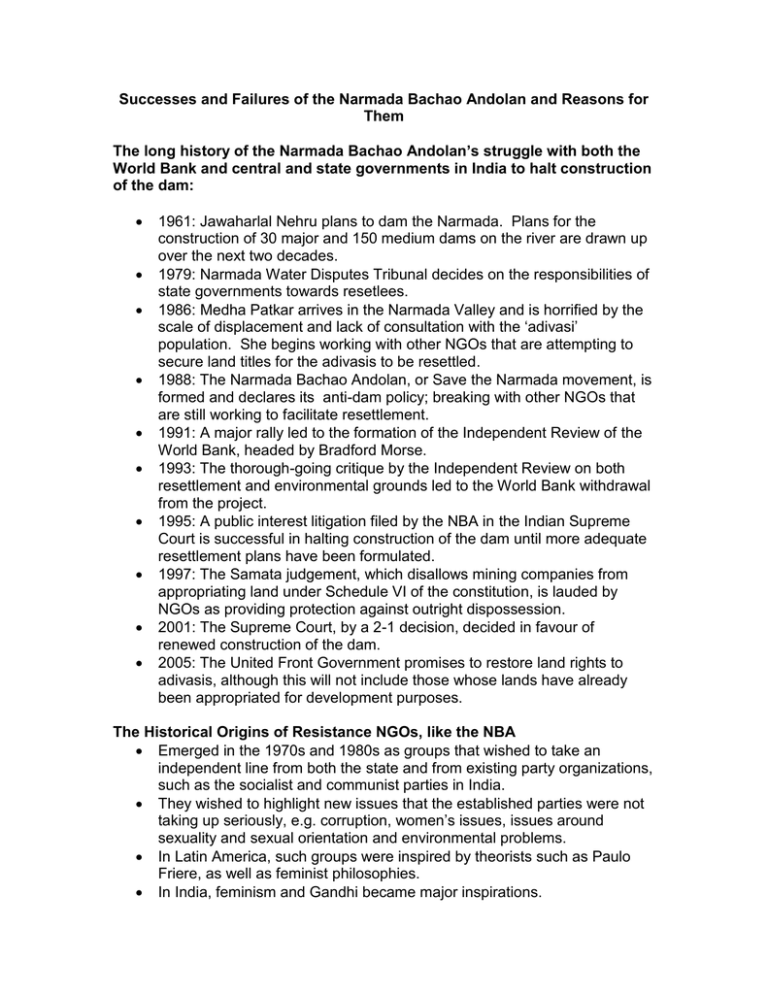
Successes and Failures of the Narmada Bachao Andolan and Reasons for Them The long history of the Narmada Bachao Andolan’s struggle with both the World Bank and central and state governments in India to halt construction of the dam: 1961: Jawaharlal Nehru plans to dam the Narmada. Plans for the construction of 30 major and 150 medium dams on the river are drawn up over the next two decades. 1979: Narmada Water Disputes Tribunal decides on the responsibilities of state governments towards resetlees. 1986: Medha Patkar arrives in the Narmada Valley and is horrified by the scale of displacement and lack of consultation with the ‘adivasi’ population. She begins working with other NGOs that are attempting to secure land titles for the adivasis to be resettled. 1988: The Narmada Bachao Andolan, or Save the Narmada movement, is formed and declares its anti-dam policy; breaking with other NGOs that are still working to facilitate resettlement. 1991: A major rally led to the formation of the Independent Review of the World Bank, headed by Bradford Morse. 1993: The thorough-going critique by the Independent Review on both resettlement and environmental grounds led to the World Bank withdrawal from the project. 1995: A public interest litigation filed by the NBA in the Indian Supreme Court is successful in halting construction of the dam until more adequate resettlement plans have been formulated. 1997: The Samata judgement, which disallows mining companies from appropriating land under Schedule VI of the constitution, is lauded by NGOs as providing protection against outright dispossession. 2001: The Supreme Court, by a 2-1 decision, decided in favour of renewed construction of the dam. 2005: The United Front Government promises to restore land rights to adivasis, although this will not include those whose lands have already been appropriated for development purposes. The Historical Origins of Resistance NGOs, like the NBA Emerged in the 1970s and 1980s as groups that wished to take an independent line from both the state and from existing party organizations, such as the socialist and communist parties in India. They wished to highlight new issues that the established parties were not taking up seriously, e.g. corruption, women’s issues, issues around sexuality and sexual orientation and environmental problems. In Latin America, such groups were inspired by theorists such as Paulo Friere, as well as feminist philosophies. In India, feminism and Gandhi became major inspirations. JP Movement in the late 1970s: anti-corruption and calling for a new type of revolution. They were anti-state, anti-capitalist, but also against what they felt was an orthodoxy found in established oppositional parties and organizations, e.g. unions. The Neoliberal Turn and the Role of NGOs Neoliberal policies have reshaped the state: o Cutbacks in health-care and education, as well as social welfare. (‘shrinking’ of the state). o Reorientation towards attracting private direct investment. o Emphasis on security and an enlargement of the repressive role of the state. o Contracting out of human rights, social, educational and medical functions to NGOs. o Basically, neoliberal policy makers views NGOs as providing the social cushion that the state has gotten rid of. o This is not the role that organizations, such as the NBA, see for themselves. o Criticisms that NGOs can only provide bandaid solutions to widespread poverty, lack of education and healthcare. Neoliberalism and Shared Hegemonies Policies and policing are now shared by a variety of national and multinational organizations. This allows national governments to pass the buck for instituting policies that are unpopular and produce inequality. It also allows the state to ignore human rights and social issues while passing the blame for such policies onto international organizations. Resistance organizations have responded by forging transnational linkages with similar groups in other countries. Yet these transnational linkages also have the danger of changing the local character of the movement. The Case of the Narmada Bachao Andolan They achieved their early successes through being able to forge transnational linkages and to petition international organizations such as the World Bank. Their transnational linkages, however, also entailed their insertion into an international environmental discourse that was dominated by western groups, who focused on the environmental degradation caused by large dams. Indian environmental movements, however, had emerged as social environmental movements, stressing the rights of small-scale rural producers over resources that were being depleted by commercialization. This focus was indigenous because common property in rural areas, e.g. forest resources, grazing lands, and common water resources were most important for the rural poor to survive. Environmental degradation of these resources affected these populations the most. Environmental degradation was simultaneously a class issue. As the Narmada Bachao Andolan became internationally recognized and successful, it tended to lose its local base. This disjuncture between urban, middle-class activists and the adivasi leadership was increased through the focus on western environmental discourse. Lack of organic, adivasi leadership in the NBA. Representation of the adivasis as ‘naturally conservationist’ appealed to international environmentalists, but exaggerated their ‘primitivism.’ The disjuncture between the local and transnational led to a drop in support for the NBA in Gujarat and the withdrawal of significant adivasi leaders in the court case that would decide the fate of the movement.
